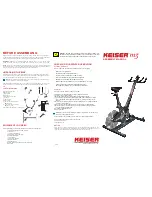
24
• a drive chain
a. Shifting Gears
There are several different types and styles of shifting controls: levers, twist grips, triggers,
combination shift/brake controls, push buttons, and so on. Ask your dealer or local bike shop to
explain the type of shifting controls that are on your bike, and to show you how they work.
The vocabulary of shifting can be pretty confusing. A downshift is a shift to a “lower” or “slower” gear,
one that is easier to pedal. An upshift is a shift to a “higher” or “faster”, harder to pedal gear. What’s
confusing is that what’s happening at the front deraileur is the opposite of what’s happening at the
rear deraileur (for details, read the instructions on Shifting the Rear Deraileur and Shifting the Front
Deraileur below). For example, you can select a gear which will make pedaling easier on a hill (make
a downshift) in one of two ways: shift the chain down the gear “steps” to a smaller gear at the front, or
up the gear “steps” to a larger gear at the rear. So, at the rear gear cluster, what is called a downshift
looks like an upshift. The way to keep things straight is to remember that shifting the chain in towards
the centerline of the bike is for accelerating and climbing and is called a downshift. Moving the chain
out or away from the centerline of the bike is for speed and is called an upshift.
Whether upshifting or downshifting, the bicycle deraileur system design requires that the drive chain
be moving forward and be under at least some tension. A deraileur will shift only if you are pedaling
forward.
CAUTION
: Never move the shifter while pedaling backward, or pedal backwards
immediately after having moved the shifter. This could jam the chain and cause serious
damage to the bicycle.
b. Shifting the Rear Deraileur
The right shifter controls the rear deraileur .
The function of the rear deraileur is to move the drive chain from one gear sprocket to another. The
smaller sprockets on the gear cluster produce higher gear ratios. Pedaling in the higher gears
requires greater pedaling effort, but takes you a greater distance with each revolution of the pedal
cranks. The larger sprockets produce lower gear ratios. Using them requires less pedaling effort, but
takes you a shorter distance with each pedal crank revolution. Moving the chain from a smaller
sprocket of the gear cluster to a larger sprocket results in a downshift. Moving the chain from a larger
sprocket to a smaller sprocket results in an upshift. In order for the deraileur to move the chain from
one sprocket to another, the rider must be pedaling forward.
c. Shifting the Front Deraileur
The Sofrider and Freerider come with a wide gear ratio, however there is only a single chain ring and
therefore no front deraileur . For customers who have their local bike shop add a front deraileur , they
should not that the front deraileur , which is controlled by the left shifter, shifts the chain between the
larger and smaller chain rings. Shifting the chain onto a smaller chain ring makes pedaling easier (a
downshift). Shifting to a larger chain ring makes pedaling harder (an upshift).
d. Which gear should I be in?
Use the larger rear cogs for climbing hills and the smaller rear cogs for the greatest speed. Find the
“starting gear” which is right for your level of ability, probably 2 or 3 — a gear which is hard enough
for quick acceleration but easy enough to let you start from a stop without wobbling — and
experiment with upshifting and downshifting to get a feel for the different gear combinations. At first,
practice shifting where there are no obstacles, hazards or other traffic, until you’ve built up your
confidence.
Shifting from an easier, “slower” gear (like 1) to a harder, “faster” gear (like 2 or 3) is called an upshift.
Shifting from a harder, “faster” gear to an easier, “slower” gear is called a downshift. Learn to
anticipate the need to shift, and shift to a lower gear
before
the hill gets too steep. If you have















































